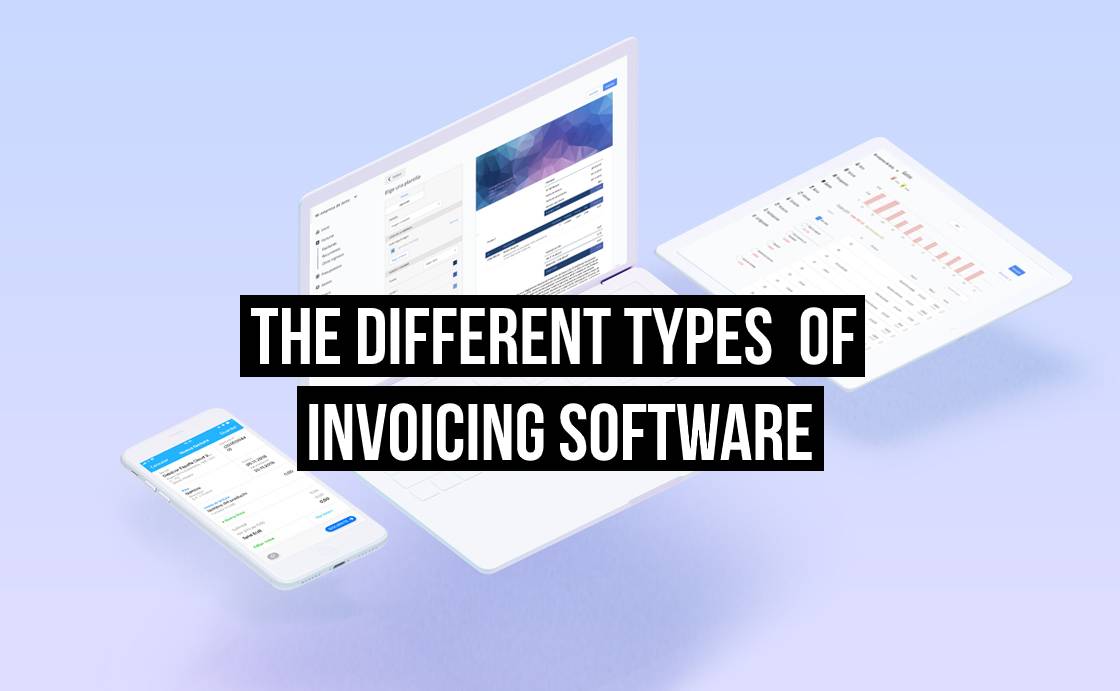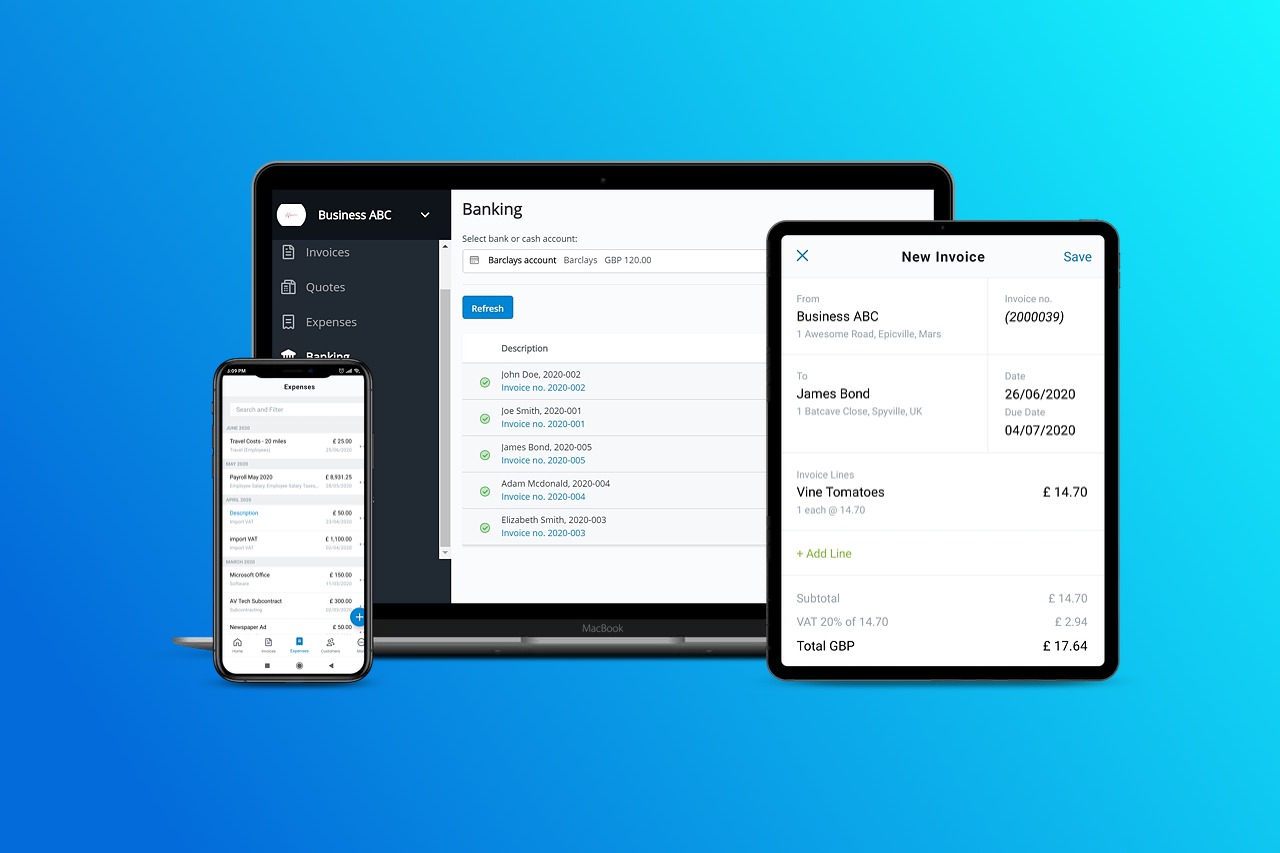Whether you’re starting your own business, or looking for a new way to issue invoices, invoicing software can help you manage your company’s finances. Invoicing software can help you create and send invoices and quotes, keep track of expenses and payments, and create automatic accounting reports.

There are two main categories of invoicing software, online and offline. I’ll explain the differences between them and also explain other types of invoicing software that may suit your business.
Online invoicing software
Online invoicing software is exactly how it sounds, online. It takes the paper out of paperwork and keeps all of your invoices and financial documents organised in one easy to use platform.
Online invoicing requires a device, such as a phone, computer, or tablet, and an internet connection so that everything is saved to the cloud.
With online invoicing software, like Debitoor, you can create and send customised invoices, quotes, credit notes, and payment reminders. You can also keep track of important accounting reports, and your VAT reports.
Another benefit to online invoicing software is that you can invoice on the go, from any device with an internet connection, from anywhere in the world. Everything is automatically saved to the cloud so if you need to access something from home instead of the office, it can easily be done.

Online invoicing software is easy to use, even with no previous accounting knowledge. It will make sure that all legally required details are inputted correctly, and keep everything organised so you don’t have to rummage through a pile of paper.
If you do have an accountant though, you can invite them to access your important documents remotely.
Online invoicing software is constantly changing and evolving. New features are added as the world becomes more digital. You can link HMRC to automatically submit VAT reports, and use OCR technology to take a picture of a receipt, and the system will log all of the details.
Most online invoicing software will allow you to connect payment accounts or card readers so you can get paid faster. It is also possible to connect a bank account for automatic bank reconciliation.
Although invoicing software costs a small fee (usually a monthly or yearly subscription), it will ultimately save you time, money, and stress.
Offline invoicing software
Offline invoicing software refers to a software that needs to be installed on your device, and does not save to the cloud. Offline invoicing software can either connect to the internet or not.
The most common form of offline invoicing software are programs like Word or Excel, where you create an invoice, download it to your computer, and either send it by email, or by post to your customer.
The downsides of offline software
This process can be quite time consuming and can lead to lots of paperwork, and potential data loss and human error. Although this method does not generally require a subscription fee, it may add costs in the respect that a worker has to manually create an invoice and send it to the customer, which can take several minutes to hours to complete.
This method of invoicing also does not create automatic reports like your balance sheet, the profit & loss statement. You will need to manually create these using all of your invoices and receipts.
Another type of offline invoicing software can be a program that you install on your computer that can connect to the internet. This software can create invoices and quotes, send them to your customers, and include options to connect accounts, and view accounting records.
This differs from online invoicing software as it is a program installed on your computer or device, rather than using a browser or mobile app. It also does not sync to the cloud, but rather saves to the program itself, or as files on your computer.

The reason that this is important is because if for some reason your computer crashes, and you don’t have the information backed up, all data will be lost.
Often, business owners stick with offline software as they think it is easier to use and easier to keep track of their finances. In this day and age, this may not be the case
In most cases, using online invoicing software does most of the nitty-gritty work for you, saving you precious time, and ensuring that your data is always safe and updated in the cloud.
The difference between online and offline invoicing software
The main difference between online and offline invoicing software is how the data is saved. With online invoicing software, you log in on a device and all data is saved to the cloud and can be accessed anywhere.
With offline invoicing software, the program needs to be installed on each device, and data is saved to one device. If you want to transfer data from one device to another, you would need to download it from one device, and upload it to another.
Another difference between online and offline software is compatibility. With online invoicing software, you can log in from any device with an internet connection and browser. Offline invoicing software, however, may have specific compatibility requirements to download the software to your device. If your device is not compatible, you cannot use the program.

Desktop invoicing software
Desktop invoicing software is downloaded to your computer and can either be online or offline. Most of the time, desktop software is offline, so it does not save or sync data over the internet.
There are some online invoicing software that allows you to download a program to your computer for offline use. This can be useful if you don’t have a constant or reliable internet connection, however, this also means that you would have to print and post the invoice to the client.
Other desktop invoicing software are online so you can send data over the internet from a downloaded program on your computer. Although this may suit your business, there is potential for data loss as the data is only saved to the one device rather than the cloud.
Word and Excel are other desktop invoicing examples as they are programs downloaded to your computer for offline use. As mentioned above, these programs are quite limited in their capabilities, and everything needs to be manually inputted by the creator.
Multi-device invoicing software
Multi-device invoicing software is a type of software that allows you to access your data from any device, such as a computer, tablet or smartphone.
Multi-device software can either be online or offline. Online multi-device software allows you to log in, and sync data to the cloud. Offline multi-device software is installed to the device, and may have access to the internet to send data, but data is saved to the one device instead of the cloud.
Most online invoicing software, including Debitoor have multi-device options so you can invoice on the go from anywhere, or check on the status of invoices once you have left the office.

Multi-device invoicing software generally offer an online dashboard which can be accessed from any phone, tablet, or computer browser, and also a mobile app that can be downloaded to your phone or tablet from the app store.
Generally, the mobile app will offer limited functionality, so complex tasks such as exporting data and creating accounting reports need to be done using the computer dashboard.
Having multi-device invoicing software can help you greatly if you need to invoice on the go, have multiple people accessing the software, or need to fix or send documents to clients quickly.
Open-source invoicing software
Open-source invoicing software refers to software that can be programmed and modified to suit your business needs. Open-source software provides programmers with source code in order to change, study, and distribute the software for any reason.
Most online invoicing software will have this option, and provide API documentation on their website, in the form of information and codes for developers.
Here is an example of the API documentation that Debitoor offers:

Invoicing software for Linux
Linux is an open-source operating system. It differs from other operating systems like Microsoft Windows and Apple macOS, as it allows programmers to change and customise the system itself.
Although Linux is customisable, you can still run most of the same programs and browsers as you would on another operating system. In most cases, you can use either online or offline invoicing software on Linux systems. Offline software, however, needs to be compatible with Linux.
Which type of invoicing software should I choose?
Ultimately, it depends on what you need accounting-wise for your business. If you only make a couple invoices a month, then maybe offline invoicing would work for you. If you need detailed accounting records, and multiple functions, then online invoicing software may be best.
Offline invoicing may make it difficult and costly to manage your finances, especially if your business has several transactions each day. It also opens the door for potential data loss if the device with the program installed crashes.
Online invoicing software can simplify the process for you and make sure you always get paid on time, never lose any data, and always have access to your reports.
There are many different types of invoicing software out there that can suit your business needs and technological situation. Feel free to give Debitoor a try with a 7-day free trial.
